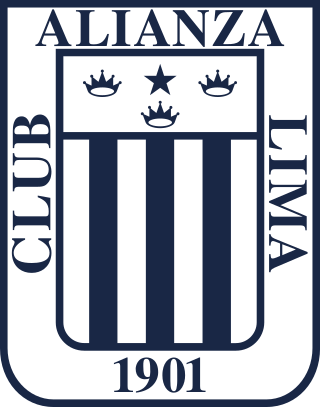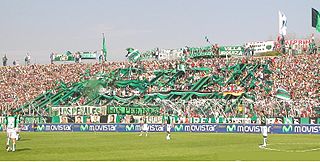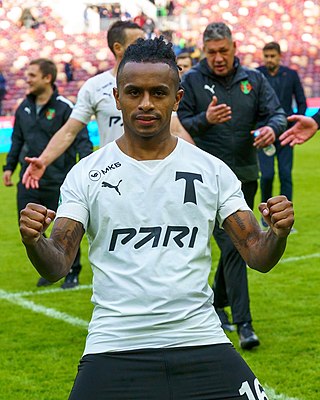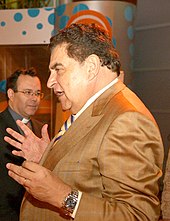
A football chant or terrace chant is a form of vocalisation performed by supporters of association football, typically during football matches. Football chanting is an expression of collective identity, most often used by fans to express their pride in the team they support, or to encourage them, and to celebrate a particular player or manager. Fans may also use football chants to slight the opposition, and many fans sing songs about their club rivals, even when they are not playing them. Sometimes the chants are spontaneous reactions to events on the pitch.

Club Sporting Cristal S.A. is a Peruvian sports club located in the city of Lima, best known for its football team. It was founded on 13 December 1955 in the Rímac district by engineer Richard Bentín Mujica and his wife Esther Grande de Bentín, stockholders of the Peruvian brewery Backus and Johnston. The club and the brewery have been closely linked since its inception, and it is for this reason that it is popularly known as los Cerveceros.

Club Alianza Lima, more commonly known as simply Alianza Lima, is a Peruvian professional sports club based in La Victoria District of Lima, Peru. The club was founded under the name of Sport Alianza on 15 February 1901 by working-class youth in the Chacaritas neighborhood of Lima. It is widely known for having one of the most historical and successful football teams in Peru; they have won a total of 25 official league titles of the Peruvian Primera División and are currently the oldest team playing in that competition, since the club was founded in 1901. According to CONMEBOL, it is considered the most popular club in Peru, and the 6th most popular club in South America, with more than 12 million fans as of April 2016.

Club Universitario de Deportes is a Peruvian sports club based in Lima, which has football as its main activity. It also has women's football, volleyball and basketball sections. The football team, popularly known as Universitario, has competed in the top tier of Peruvian football, the Liga 1, since 1928. They are the most successful team in Peruvian football with 28 titles and have never been relegated. The club was founded in August 1924 under the name Federación Universitaria by students of the National University of San Marcos but was forced to rename in 1931.

Club Universidad de Chile is a professional football club based in Santiago, Chile, that plays in the Primera División.

Xerez Club Deportivo S. A. D. is a Spanish football club based in the city of Jerez de la Frontera. It was founded in 1947 and plays in Segunda Federación – Group 4.
Los de Abajo is the official barra brava of Universidad de Chile. They are one of the biggest groups of supporters in Chile. It is the team that takes the most people to the stadium in Chile.

"Vamos, vamos, Argentina" is an Argentinan chant, used by supporters in sports events, mainly in football matches of the national team and related celebrations.

Barra brava is the name of organized supporters' groups of football teams in Argentina, analogous to European ultras and British hooligans in providing fanatical support to their clubs in stadiums and provoking violence against rival fans as well as against the police.

The Chile–Peru football rivalry is a long-standing association football rivalry between the national football teams of Peru and Chile and their respective aficionados. Both teams compete in FIFA's South American Football Confederation (CONMEBOL). Matches between the two nations are keenly contested and their games have a reputation for fierceness in and off the field of play, fueled by political disputes.
Football is the most popular sport in Peru. Football/soccer in Peru was introduced by British immigrants, Peruvians returning from Great Britain, and by English sailors in the later half of the 19th century during their frequent stops at the port of Callao, which at that point was considered one of the most important ports of the Pacific Ocean. According to the work entitled La Difusión del Fútbol en Lima, during the last decade of the 19th century, records show that sailors were known to practice sports such as football/soccer and played against teams made up of Englishmen, Peruvians, or a mix between Englishmen and Peruvians.

Alfonso Ugarte de Chiclín is a Peruvian football club, playing in the city of Trujillo, Peru. The club is the biggest of Trujillo city, and one of the biggest in La Libertad Province.

Raúl Mario Ruidíaz Misitich is a Peruvian professional footballer who last played as a striker for Major League Soccer club Seattle Sounders FC and the Peru national team.

The 1996 Chilean telethon was the 14th version of the solidarity campaign conducted in Chile. It took place on 6 and 7 December 1996. The theme of this version was "Another step forward."

Edison Michael Flores Peralta is a Peruvian professional footballer who plays as a forward for Peruvian Liga 1 club Universitario de Deportes, on loan from Liga MX club Atlas, and the Peru national team.

José Yordy Reyna Serna is a Peruvian professional footballer who plays as a striker for Russian club Rodina Moscow on loan from Torpedo Moscow.

The Trinchera Celeste is an independent supporters group of O'Higgins, a football club in the Primera División de Chile. It's known as the barra brava of the club.
Miguel Ángel Vargas Mañán is a Chilean footballer who currently plays for Universitario de Deportes as a goalkeeper.
Parcko Geovanni Quiroz Figueroa is a Chilean former football player who played as a defender for clubs in Chile and Peru.
















